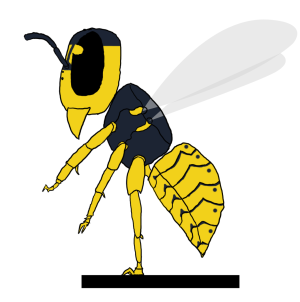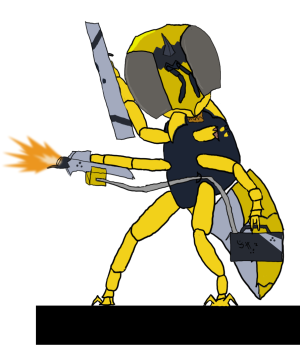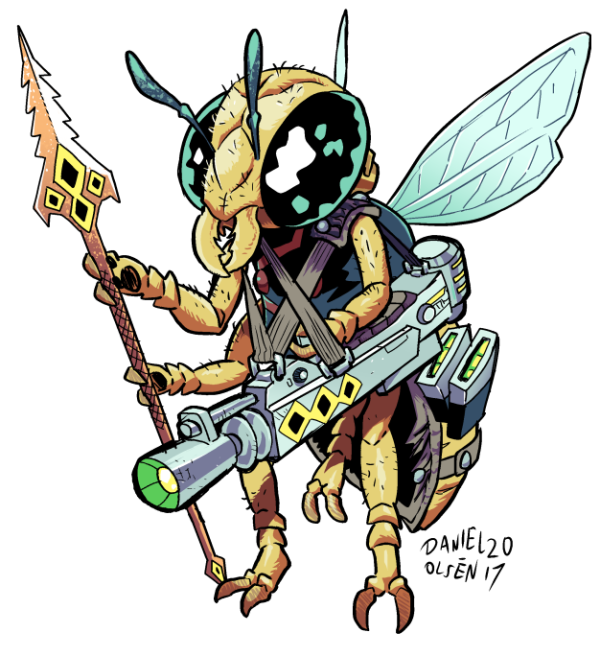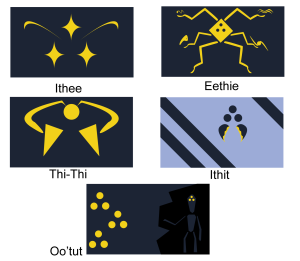Sidebar
Table of Contents
I'ee
The I'ee are a species of insectoid alien that hail far from most civilised areas, making their home within the Ee'ee system. Their physical appearance is greatly similar to those of old Earth vespulae. Their physique is short and stocky, with a metabolism that necessitates frequent sleep and a diet of high-energy fluid meals. Due to their remote location and slow rate of expansion, they have been isolated for quite some time. Their first contact with sentient species ended in warfare, and as a result, they have been studying foreign civilisations with as much secrecy as possible, only recently making contact with trained ambassadors.
History
The I'ee have lived in family units numbering in the tens of thousands for countless centuries, having roots similar to those of most terrestrial super-organisms. The progress from a tribal society to civilised progression took quite some time, thanks to the I'ee's natural drive to propagate a simple cycle of reproduction and resource collection, with little room for experimentation. For the greater part of their history, the I'ee rode a fine line between being feral animals and possessing a rudimentary civilisation.
Ee'ee, the home planet of the I'ee, was once home to an alien civilisation unrelated to the I'ee. Compared to the tribal insectoids, these aliens had technology and culture similar to those of most humanoid species. It was this civilisation that saw potential in the I'ee's psychology and thus-far untapped intelligence. The resulting assimilation of the I'ee into a modern civilisation was known as the First Restructuring Event.
Initially, this period of experimentation and uplifting resulted in a number of pampered I'ee families: With necessities such as food provided much more freely than in the wild, they found more time to partake in more intellectual pursuits such as art and philosophy. On the other hand, I'ee families began to be bred solely for use in factory and other work environments. Effectively slaves, these families were wholly given over to their mindless manufacturing tasks, precluding mental development.
The Second Restructuring Event came during a period of apocalypse upon Ee'ee. The I'ee's progenitor race, whose name is lost to time, was locked in an interstellar war with an alien civilisation. Caught on the losing side, many new I'ee families were swept up and trained as soldiers and crew members; some families even controlled whole auxiliary fleets. Eventually, the progenitors were brought to their knees and, in the chaos that followed, the countless 'slave' I'ee families; provoked by the unfamiliar and frightening stimuli, revolted violently.
With the progenitor civilisation's capital, Ee'ee, torn apart from the inside by countless, practically feral I'ee, the enemy soon came upon a planet that did not need conquering. Amused, or perhaps simply curious, they let the I'ee be, leaving observation devices in orbit around the home world. With the chaos of war gone, and the progenitor race dead, the slave I'ee went back to their old tasks. In a world that had came to depend on their ceaseless diligence so completely, Ee'ee's industry was soon back to full capacity.
The only problem was that there was no one left to use this industry. No one except for the pampered I'ee families that had been the object of so many social experiments. Left to reclaim a soulless, automated world with nothing but their own creativity, the I'ee intellectuals spent many years doing what they had always enjoyed: Art, philosophy and other creative pursuits, some of excessive scale. Finally, the curious queens of the I'ee turned their gaze towards the stars, wishing to discover their secrets.
Currently, the I'ee species is in the midst of their Third and perhaps most important Restructuring Event. While the oldest and largest I'ee families have found themselves content to observe the stars from the comfort of Ee'ee, gradually expanding outward, the youngest families have no such patience. With the discovery of new and bizarre alien species and civilisations to pique their curiousity, families such as Ee'ith have taken it upon themselves to introduce the I'ee species to the galaxy at large, for better or for worse.
Physiology
 The I'ee have a similarity to old Earth insects which can not be understated, possessing a head, thorax, abdomen and six legs along with two pairs of wings. Despite being perfectly capable of crawling using all six legs, the wasp-like aliens have begun adopting a two-legged stance as their technological prowess increases. When using all legs, the I'ee, for all intents and purposes, look like a giant, yellow-jacket wasp with a length of about four feet in worker females.
When standing on their hind legs, they bear a rather stocky, hunched over appearance to compensate for the weight of their abdomen. Each leg ends in a pair of dexterous claws with a soft, gripping pad situated within the 'palm'. The thorax and head each have a sparse coat of fuzzy hairs which can be used to detect touch, with similar hairs scattered along each leg. As with some terrestrial hymenoptera, I'ee females possess a modified ovipositor capable of injecting venom into their foes; more commonly known as a stinger.
The I'ee have a similarity to old Earth insects which can not be understated, possessing a head, thorax, abdomen and six legs along with two pairs of wings. Despite being perfectly capable of crawling using all six legs, the wasp-like aliens have begun adopting a two-legged stance as their technological prowess increases. When using all legs, the I'ee, for all intents and purposes, look like a giant, yellow-jacket wasp with a length of about four feet in worker females.
When standing on their hind legs, they bear a rather stocky, hunched over appearance to compensate for the weight of their abdomen. Each leg ends in a pair of dexterous claws with a soft, gripping pad situated within the 'palm'. The thorax and head each have a sparse coat of fuzzy hairs which can be used to detect touch, with similar hairs scattered along each leg. As with some terrestrial hymenoptera, I'ee females possess a modified ovipositor capable of injecting venom into their foes; more commonly known as a stinger.
Culture
For information on I'ee castes, see this page.
For more information on the I'ee families, see this page.
For information on the I'ee language, see this page.
The I'ee communicate with one another primarily through a mixture of 'song' and dance, being able to produce a variety of flutey squeaks, hisses and huffs through the spiracles they breathe through. With the increasing time constraints demanded by modern technology and communication, dance has become a more recreational form of self-expression amongst the I'ee. Individual I'ee generally do not take on names, due to the sheer number of individuals present in each family. Family members identify one another through scent and facial markings, with only the queen of each family taking on a specific name. Modern record-keeping systems also give each individual I'ee a number to identify them by for the purposes of censuses and history records.
The modern I'ee families have recently undertook a collaborative effort to unify their species technologically, compartmentalising their species by focusing each family's progression upon a specific role or task. A list of the current families and their functions is as follows:
Primary
- Ith'ee (Aerospace Development)
- Ee'thie (Logistics and Resource Management)
- Thi-thi (Armed Forces)
- Ith'it (Weapons Development)
- Oo'tut (Xenology)
Secondary
- Ee'ith (Foreign Relations)
- Thoot (Deep Space Resource Collection)
- I'oth (Medical Study and Practice)
Technology
Weaponry and Armour
Due to a general lack of experience in warfare, and the I'ee's method of honour dueling to solve internal disputes, their weaponry has for a long time been ornamental in nature and ill suited towards 'proper' warfare. Generally, the warriors of the I'ee are outfitted with a focus on melee combat in mind. Horned helmets, bladed stinger and mandible augmentations, caesti and small pikes are traditional weapons still seen in use. In regards to more modern, projectile based combat, there exists a chasm between pre-I'ee designs and those created by the I'ee themselves. The latter are generally more experimental and less practical. I'ee firearms are built around the weakness inherent in their lack of a wrist: Handguns have their mass centered around the handle in an effort to mitigate weight. Heavier weapons often have several handholds along with straps designed to be secured to a harness.

Starship Design
The motif of close-quarters combat was carried over into the I'ee's early starships, with most being outfitted with multiple sharp ramming prongs. I'ee marines are trained in extra-vehicular activity, and literally climb from their ship to the enemy's in order to cut their way inside. Ranged space weaponry generally takes the form of coil guns, firing slugs of metal at high speeds. Such projectiles are sometimes made with radioactive components in a reckless effort to poison enemy crew. Due to their relatively short life-span and robust physiology, negative side-effects of radiation tend not to affect their people.
Architecture
The general theme in I'ee architecture, in buildings, weapons and vehicles, is that of primarily gold-black colours and sharp, organic looking protrusions contrasting with a jagged, blocky structural shape. I'ee buildings are mostly based underground, with ornate, tall entrance structures and sprawling labyrinths of functional tunnels. I'ee starships are generally long and flat in shape in order to present a small target, and also to provide more 'cushioning' for the ship when ramming an enemy. To facilitate this further, their ships are fitted with special thrusters to initiate ramming speed, and bear long, wicked blades and spikes upon their bow.
Related Characters
PC
NPC
Related Starships
Related Weaponry
Related Technology
OOC Notes
Littlewasp created this article on 2015/12/20 03:29.
Page Tools
Terms of Service - Privacy Policy



